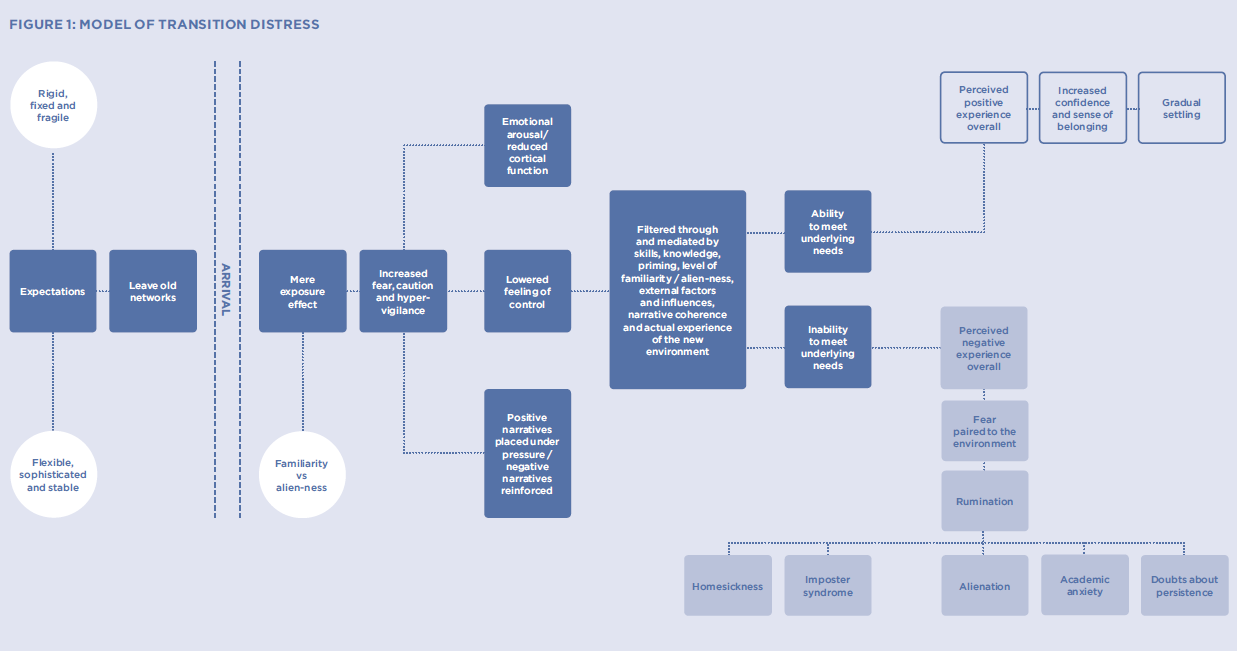It will come as no surprise to anybody working within higher education, that many students find the transition into university emotionally and psychologically difficult. We clearly understand that students going through transition can experience psychological distress, anxiety, depression, sleep disturbance, a reduction in self-esteem and isolation.1–5 Many students describe a loss of feelings of control, and doubts about whether or not to stay at their new university.
This is particularly concerning for universities, as research has identified that successful transition is a key element in determining retention and future student success.6–10 While most of us probably recognise all of this, there is often less understanding about why some students find transition so difficult, and more importantly, what we can do about it.
In the last few years, I and my colleagues in Student Wellbeing at the University of Derby have been researching student transition in order to develop better interventions to support new students.
Our research, and the research of many others in the field, suggests that we may need to rethink some of the ways in which we approach transition, if we want to provide our students with the most effective support. In this article, I briefly describe some of our work so far (some of which has been published and presented elsewhere), and propose a new model of transition. I do this with one important caveat. As George Box said: ‘All models are wrong, but some models are useful.’11 I don’t pretend that this model encapsulates every single student’s experience but I hope it may provide a useful way of thinking about what our students may be experiencing, how we can target our support and how this learning can be used to good effect in the therapy room.
Transition distress
Traditionally, early student distress was thought to be largely caused by homesickness, defined by Fisher and Hood as a ‘cognitive-motivational-emotional state’ concerned with ‘grieving for, yearning for and being preoccupied with thoughts of home’.2 Obviously, we do see this within the first few weeks of term, but both within my own work with students and in the research, this doesn’t seem to tell the whole story. For many students who I see, homesickness doesn’t seem to properly explain the distress they are experiencing. Sometimes, students who are used to being away from home for long periods of time, can be blind-sided by high levels of distress that they can’t understand. Other students puzzle over the fact that they somehow feel homesick even though they are local students who haven’t left home.
As part of one study, conducted with my colleague Olivia Smail, we surveyed a random sample of new students in the first six weeks using CORE-GP and a questionnaire we devised ourselves.12 (CORE-GP is a version of the CORE outcome measure used in many counselling services and has been developed for use with the general population.) Of around 350 students, 63 per cent were found to be experiencing clinical levels of distress as measured on CORE. We had assumed that there would be a difference in the level of distress between those who had left home to come to university and those who were commuting locally. We believed we could identify this difference as homesickness. However, when we analysed the data, we found no statistical difference in the level of distress experienced by these two groups. Local students were just as distressed; homesickness was not the total explanation.
Now, of course, this was a small study but these data do fit with research from elsewhere. For instance, in Australia and New Zealand the majority of students tend to commute to their local universities and yet colleagues there find similar levels of emotional distress and student difficulties with transition.13 This suggests that there may be something about the entry into university that can be a trigger for distress in and of itself – it is not always or entirely caused by the exit from old networks.
I will return to this point for a possible explanation later.
However, this study also identified some potentially interesting correlations that suggested that the emotional experiences of students may play a key role in how well they are able to integrate into their new environment.12 Students who were experiencing clinical levels of distress were more likely to identify that they felt lonely, overwhelmed, angry, restless, homesick, that they were struggling to make decisions and that they believed they should have been doing better.
Students who were in the non-clinical range were more likely to indicate that they felt they had settled in, that they felt part of the community, that they regarded negative thoughts and feelings as temporary and that they believed they were ready to start their course.
What impacts on students?
In another study we asked just under 500 students, during their first six weeks at university, to identify what had helped to make their early experiences better and what had made them worse.5 Three key themes emerged.
The first concerned the importance of social support. Students identified that making new friends and keeping in contact with old friends had a beneficial impact, while being alone or feeling socially isolated had a negative impact. Secondly, students identified that their own thinking, behaviour and lifestyle were important factors in ensuring a successful transition. When indicating what had helped, a number identified cognitive strategies and practical activities to support their own wellbeing. In contrast, when identifying what had made things worse, some students talked about negative, ruminative thinking, and behaviours, such as drinking too much, which had made things more difficult. Finally, students identified that the actions of universities had significant positive and negative effects on their transition. Well-designed activities that raised their motivation and sense of belonging and helped them to integrate socially were seen as helpful, while administrative and practical things going wrong were seen to have a negative influence overall.
All of this, and much other research, supports the view that transition is a psychological process, influenced by social and practical factors, probably beginning as soon as a student starts to think about university, and continuing at least until the end of the first year. As universities, we can have positive and negative impacts on this process, either helping students to transition successfully or making it more difficult (often without meaning to). Well designed and effectively delivered support can reduce the levels of distress our students experience, increasing retention and student success. The dilemma that naturally follows is what we should target and how that support should be designed. It is for this reason that an overarching model of transition may be helpful.
Preparation and expectation
Vincent Tinto has written extensively about the impact of the social and cultural experiences of students before they go to university.6,7 He has argued that the influences that students encounter prior to starting their courses determine how well prepared they are to integrate both socially and academically into higher education. These influences also help to set students’ expectations about what university will be like and how they will respond to their new environment. Research suggests that many students have vague or unrealistic expectations of university. In a study we are currently running, sixth form teachers confirm that many students have difficulty in visualising the future and are often unrealistic in their beliefs. This suggests that helping students to set realistic expectations about university would improve their transition experiences. However, much work has shown that persuading people to change their views and beliefs about future events can be extremely difficult, and universities can expend much energy and resource on trying to alter student expectations to no effect 7,14. In fact, the research seems to show that the key element in student expectations is not whether they are accurate but whether they are flexible, sophisticated and stable, or rigid, fixed and fragile.10 Helping students to expand their expectations and understand that they may have varying experiences – both good and not so good – may be more productive than attempting to challenge and change their current beliefs.
Skills
There is also significant evidence that many students arrive at university without the personal, social and academic skills they require to successfully transition to university.15–17 Issues of time management, resilience, managing relationships and budgeting recur in the literature. There are also indications that changes in education have driven students towards an exam and grade-focused approach to learning in which they are passive recipients of knowledge.17–19 This is problematic, not only because university students are expected to be responsible for much of their own learning but also because surface learning is likely to result in higher levels of anxiety and lower academic achievement overall. 20 Interventions which help students to acquire these skills before arrival and alter their approach to learning could, therefore, have a positive impact. We can often see this in the recognised effectiveness of many summer schools and schemes which seek to engage students with preparing for university21.
Arrival at university
I promised earlier that I would return to the possible causes of the distress many students experience at the point of transition to university. Clearly, there are many elements at play for each student, and leaving old networks and environments will still have a significant effect for many students. However, if we think about the possible unsettling impact of entry into a new environment, there is one intriguing possible explanation.
Robert Zajonc was a Polish-born American psychologist who developed the ‘mere exposure’ theory.’22 He noticed that most living things tended to have an initial fear/avoidance response to new stimuli but that when exposed to the same stimuli repeatedly, they became comfortable with it and eventually grew to like it. He theorised that this reaction helped to keep people safe in new environments. If a situation was familiar, they could immediately judge how safe it was; if something was alien, they would be wary until sufficient exposure established it as safe. For new students, this means that entering into a new and potentially highly alien environment (a university), will immediately trigger hyperarousal and a possible fear response. This state of emotional arousal will make it more difficult to process new information, make decisions and complete cognitively demanding tasks, just at the very moment that many university induction schedules are bombarding them with new information and when they are being asked to undertake new and complex activities.
This might also partly explain why some students, from non-traditional backgrounds, can find the transition to university more difficult. In other words, the more alien a new university is, the more likely students are to become negatively emotionally aroused. The fact that repeated exposure to a new environment can overcome these negative feelings helpfully points to some potential solutions. Quick and effective familiarisation with the new environment should help students to reduce these feelings quickly. Indeed, research we have conducted to evaluate our transition support for students with autism, and our pre-entry events for disabled students has indicated that these students found familiarisation activities to be among the most helpful. In the research quoted earlier, we also found that students who had been to the university before for open or visit days or for summer schools, generally had lower levels of distress.
The impact of students' ability to meet their own needs
Finally, I would suggest that needs theories provide a useful way of thinking about how well students complete their transition to university. Needs theories suggest that distress generally occurs when people are unable to keep their underlying physical and emotional needs in balance.23–25 Big changes and new, pressured environments can jeopardise or even prevent our ability to meet these needs. For students, meeting needs requires them, for instance, to be able to feed themselves, manage their own sleep, feel an appropriate level of security and control, feel socially connected, understand their own sense of purpose and feel a sense of competence (which may come, although not exclusively, from their academic work). If students are able to meet these needs in this new environment then we can expect them to settle in well and begin to thrive. If students are unable to meet these needs, due to a lack of necessary skills, heightened emotional arousal or a lack of necessary support, then they will find transition more difficult and more distressing.
Conclusions
This, then, is our general model.

Transition begins pre-entry, with a student’s social and cultural experiences establishing a narrative, contributing to their expectations and either providing them with necessary skills or not. Students then enter university, potentially leaving old networks and entering a new environment – both of which may trigger heightened arousal and a fear response, which may be exacerbated by how alien the new environment appears to them. Successful transition is then determined by how able a student is to meet their needs in this new environment. Students who can meet their needs quickly become comfortable and have the potential to thrive. Students who are unable to meet their needs potentially experience higher levels of distress for longer, may feel alienated from the university, lose belief and may consider leaving.
If this model is, as I hope, useful, it offers universities multiple opportunities to impact positively on student transition. Outreach work into schools can help to expand student expectations and highlight the importance of acquiring key skills. Summer schools and pre-entry events can build on this work and help students to become familiar with their new university quickly. Induction events can address heightened emotional arousal, normalising and reducing it, posing new helpful narratives and encouraging students to engage fully with student life to speed up belonging. Curricula and support can focus on helping students to identify and acquire missing skills, so they can quickly meet their own needs.
I’m aware that this is a relatively short article and I’ve had to cover a lot of ground quickly, but I want to finish by reflecting, a little, on what this might mean when we are providing therapy/counselling to new students.
In my own therapy work with students, I have found that simply helping them to understand the processes they’re going through can normalise and significantly reduce the level of emotional distress they are experiencing. Helping students to visualise themselves moving around the university and imagining themselves enjoying being there can also speed up the process of settling in. Action plans to acquire skills, as well as recognising and using the strengths they already have, can contribute to an increase in their sense of confidence and competence. It can also be useful to clarify the expectations students bring, and by questioning, reflecting and creating new stories together, expand their versions of what they think university should be like, allowing them multiple responses.
I firmly believe that many of our students experience more stress and distress than is necessary and that these feelings reduce their enjoyment of university, and impact negatively on their achievement. I also believe that these feelings can be changed.
Gareth Hughes is a psychotherapist working in Psychological Wellbeing at the University of Derby and is Research Lead for Student Wellbeing. He is also a tutor for the Human Givens College, providing training on overcoming academic anxiety and the links between learning and wellbeing.
More from University and College Counselling

College counselling in the age of biological psychiatry: a Szaszian perspective
Open article: John Breeding undertakes a critical examination of psychiatric narratives of mental illness, and considers the work of Thomas Szasz as a corrective lens through which to view student distress. University and College Counselling, May 2016

Managing a multidisciplinary wellbeing team
Open article: Nic Streatfield and Liz Prance describe the restructuring of support services within their institution and the advantages of cross-team collaboration and working. University and Colleges Counselling, March 2016

Compassion: the missing value in higher education?
Open article: When students understand the value of compassion, they can develop a healthier acceptance of their imperfections, a greater tolerance towards others, and ultimately more emotional resilience, suggests David Mair. University and College Counselling, January 2016
References
1. Palmer M, O’Kane P, Owens M. Betwixt spaces: student accounts of turning point experiences in the first-year transition. Studies in Higher Education 2009; 34(1): 37–54.
2. Fisher S, Hood B. The stress of the transition to university: a longitudinal study of psychological disturbance, absent-mindedness and vulnerability to homesickness. British Journal of Psychology 1987; 78(4): 425–441.
3. Stanley N, Mallon S, Bell J, Manthorpe J. Trapped in transition: findings from a UK study of student suicide. British Journal of Guidance & Counselling 2009; 37(4): 419–433.
4. Hicks T, Heastie S. High school to college transition: a profile of the stressors, physical and psychological health issues that affect first-year on-campus college students. Journal of Cultural Diversity 2008; 15(3): 143–147.
5. Hughes G, Smail O. Which aspects of university life are most and least helpful in the transition to HE? A qualitative snapshot of student perceptions. Journal of Further and Higher Education 2014; 39(4): 466–480.
6. Tinto V. Dropout from Higher education: a theoretical synthesis of recent research. Review of Educational Research 1975; 45(1): 89–125.
7. Tinto V. Enhancing student success: lessons learned. Presentation at 16th International First Year Experience Conference, Wellington. 7–19 July, 2013.
8. Murtagh L. Enhancing preparation for higher education. Practitioner Research in Higher Education 2012; 6(1): 31–39.
9. Nelson K, Smith J, Clarke J. Enhancing the transition of commencing students into university: an institution-wide approach. Higher Education Research & Development 2012; 31(2): 185–199.
10. Harvey L, Drew S, Smith M. The first year experience: a review of literature for the Higher Education Academy. Higher Education Academy; 2006. [Online.] www.heacademy.ac.uk/sites/default/files/first_year_experience_full_report.pdf (accessed 11 July 2016).
11. Box G. Robustness in the strategy of scientific model building. In: Launer R, Wilkinson G (eds). Robustness in statistics. 1st ed. Academic Press; 1979 (pp201–236).
12. Hughes G. The role of emotion in induction. European First Year Experience Conference, Ghent; 2016. [online] sites.arteveldehogeschool.be/efye/parallel-sessions-5
13. Richardson A, King S, Garrett R, Wrench A. Thriving or just surviving? Exploring student strategies for a smoother transition to university. A practice report. The International Journal of the First Year in Higher Education 2012; 3(2).
14. Kahneman D. Thinking, fast and slow. London: Penguin Books; 2012
15. Krause K, Haertley R, James R, McInnes C. The first year experience in Australian universities: findings from a decade of national studies. [Online.] www.griffith.edu.au/__data/assets/pdf_file/0006/37491/FYEReport05.pdf (accessed 11 July 2016).
16. Lowe H, Cook A. Mind the gap: are students prepared for higher education? Journal of Further and Higher Education 2003; 27(1): 53–76.
17. Norton L, Keenan P, Williams K, Elander J, McDonough G. Helping students make the transition from A-level to degree level writing: a staged action research approach. BERA Annual Conference, Manchester. 2–5 September, 2009.
18. RAND. Teachers matter: understanding teachers’ impact on student achievement. 2012. [Online.] www.rand.org/education/projects/measuring-teacher-effectiveness/teachersmatter.html (accessed 11 July 2016).
19. Oliver C, Kettley N. Gatekeepers or facilitators: the influence of teacher habitus on students’ applications to elite universities. British Journal of Sociology of Education 2010; 31(6): 737–753.
20. Zajonc R. Mere exposure: a gateway to the subliminal. Current Directions in Psychological Science 2001; 10(6): 224–228.
21. Walker L. Longitudinal study of drop-out and continuing students who attended the pre-university summer school at the University of Glasgow. International Journal of Lifelong Education 2010; 13(3): 217–233.
22. Glasser W. Control theory. New York: Perennial Library; 1985.
23. Griffin J, Tyrrell I. Human givens: a new approach to emotional health and clear thinking. Chalvington: Human Givens Publishing; 2003.
24. Deci E. Ryan R. Handbook of self-determination research. Rochester, NY: University of Rochester Press; 2002.
